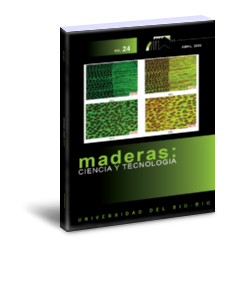Weight–strength optimization of wooden household chairs based on member section size
DOI:
https://doi.org/10.4067/s0718-221x2022000100431Keywords:
Chair performance tests, cyclic strength, engineering design, Fagus orientalis, optimization, Pinus sylvestrisAbstract
Weight-strength optimization of wooden household chairs was performed based on the member section size in this study. Member section sizes of the Scotch pine (Pinus sylvestris) and Oriental beech (Fagus orientalis) chairs were optimized and resulting re-manufactured optimized chairs were tested under the cyclic “front to back”, “back to front” and “backrest” loads according to American Library Association (ALA) specification. Finite element method (FEM) and MATLAB nonlinear programming were utilized for the optimization. Firstly, the internal forces and moments acting on each member were analyzed by FEM in order to obtain the maximum critical stresses in each type of member; then, optimized cross-sectional sizes of the members were determined by Gradient Descent method, and all constraints were treated with Logarithmic Barrier Functioning. As a result, the minimum section sizes of members were determined, and cyclic performance tests were performed to determine whether the optimized chairs were strong enough to carry the acceptable loads. According to the results, member section size of both beech and pine chairs could be significantly reduced. The reduction was 32 % in the total weight and volume for beech chairs while 16 % for pine chairs without sacrificing the performance required for domestic usage by ALA. In conclusion, the method used is suitable for the optimization of furniture frames, making it lighter and reducing the material costs.
Downloads
References
Ceylan E. 2018. Weight Strength Optimization of Wood Chairs Based on Member Section Dimensions. Master of Science Thesis, Mugla Sitki Kocman University. Institution of Science. Department of Woodworking Industrial Engineering, Muğla.
Ceylan, E.; Güray, E.; Kasal A. 2021. Structural Analyses of Wooden Chairs by Finite Element Method (FEM) And Assessment of the Cyclic Loading Performance in Comparison with Allowable Design Loads. Maderas-Cienc Tecnol 23:1–28.
https://doi.org/10.4067/s0718-221x2021 000100419
Dababneh, O.; Kipouros, T.; Whidborne, J.F. 2018. Application of an Efficient Gradient-Based Optimization Strategy for Aircraft Wing Structures. Aerospace 5(1): 3. https://doi.org/10.3390/aerospace5010003
Eckelman, C.A. 1995. Library Chairs: An Overview of the ALA Test Method with Test Reports on Side Chairs. American Library Reports, 31(2): 115-214.
Eckelman, C.A. 1999. Performance testing of side chairs. Eur J Wood Prod 57: 227–34. https://doi.org/10.1007/s001070050047.
Eckelman, C.A. 2003. Textbook of Product Engineering and Strength Design of Furniture. Purdue University: West Lafayette, Indiana, USA, 65-67.
https://www.agriculture.purdue.edu/fnr/faculty/eckelman/pdf/pdm0scan.pdf
Gustafsson, S.I. 1997. Optimizing ash wood chairs. Wood Sci Technol 31:291–301. https://doi.org/10.1007/BF00702616
Frisch, K. R., 1955. The logarithmic potential method of convex programming. Memorandum, University Institute of Economics, 5(6) Oslo.
Hu, W.; Chen, B. 2021. A Methodology for Optimizing Tenon Geometry Dimensions of Mortise-and-Tenon Joint Wood Products. Forests 12(4): 478.
https://doi.org/10.3390/f12040478
Hu, W.G.; Guan, H.Y. 2017. Research on withdrawal strength of mortise and tenon joint by numerical and analytic methods. Wood Res 62: 575-586.
http://www.woodresearch.sk/wr/201704/07.pdf
Hu, W.; Guan, H. 2019. A finite element model of semi-rigid mortise-and-tenon joint considering glue line and friction coefficient. J Wood Sci 65(1): 1-9. https://doi.org/10.1186/s10086-019-1794-4
Hu, W.; Guan, H., Zhang, J. 2018. Finite element analysis of tensile load resistance of mortise-and-tenon joints considering tenon fit effects. Wood
Fiber Sci 50(2): 121-131. https://doi.org/10.22382/wfs-2018-014
Hu, W.; Fu, W.L.; Guan, H.Y. 2018. Optimal design of stretchers positions of mortise and tenon joint chair. Wood Res 63:505–16. http://www.woodresearch.sk/wr/201803/14.pdf
Hu, W.; Liu, N. 2020. Comparisons of finite element models used to predict bending strength of mortise-and-tenon joints. BioResources 15(3): 5801-5811. https://doi.org/10.15376/biores.15.3.5801-5811
Hu, W.; Liu, N.; Guan, H. 2019. Optimal design of a furniture frame by reducing the volume of wood. Drewno 62. https://doi.org/10.12841/wood.1644-3985.275.12.
Kasal, A.; Smardzewski, J; Kuşkun, T.; Erdil Y.Z. 2016. Numerical analyses of various sizes of mortise and tenon furniture joints. BioResources 11(3): 6836-6853. https://doi.org/10.15376/biores.11.3.6836-6853
Kasal, B.; Pullela, S.V. 1995. Development of analytical models for furniture. Technical Report 95-01, Furniture manufacturing and Management Center, North Carolina State University. https://doi.org/10.12841/wood.1644-3985.275.12
Ke, Q.; Lin, L.; Chen, S.; Zhang, F.; Zhang, Y. 2016. Optimization of L-Shaped Corner Dowel Joint in Pine Using Finite Element Analysis with Taguchi Method. Wood Res 61:243–54. http://www.woodresearch.sk/wr/201602/08.pdf
Kramer, O. 2010. A Review of Constraint-Handling Techniques for Evolution Strategies. Appl Comp Intell Soft Article ID 185063 https://doi.org/10.1155/2010/185063
Rapid Interactive Structural Analysis. RISA. 2000. RISA Technologies Software. RISA Tech, Inc.Lake Forest, California. United States. https://risa.com/products/risa-3d
Smardzewski, J. 1998. Numerical analysis of furniture constructions. Wood Sci Technol 32(4): 273-286. https://doi.org/10.1007/BF00702895.
Smardzewski, J. Gawroński, T. 2001. Fem Algorithm for Chair Optimisation Electronic Journal of Polish Agricultural Universities 4(2).
http://www.ejpau.media.pl/volume4/issue2/wood/art-01.html
Smardzewski, J. Prekrat, S. 2009. Optimisation of a Sofa Frame in the Integrated Cad-Cae Environment. Electronic Journal of Polish Agricultural Universities 12(4). http://www.ejpau.media.pl/volume12/issue4/index_sabs.html
Tankut, N.; Tankut, A.N.; Zor, M. 2014. Finite Element Analysis of Wood Materials. Drv Ind 65(2): 159-171. https://doi.org/10.5552/drind.2014.1254
Zhang, T.; Hu, W. 2021. Numerical Study on Effects of Tenon Sizes on Withdrawal Load Capacity of Mortise and Tenon Joint. Wood Research 66(2): 321-330. https://doi.org/10.3390/f11030280
Downloads
Published
How to Cite
Issue
Section
License

This work is licensed under a Creative Commons Attribution 4.0 International License.
Los autores/as conservarán sus derechos de autor y garantizarán a la revista el derecho de primera publicación de su obra, el cuál estará simultáneamente sujeto a la Licencia de Reconocimiento de Creative Commons CC-BY que permite a terceros compartir la obra siempre que se indique su autor y su primera publicación esta revista.































